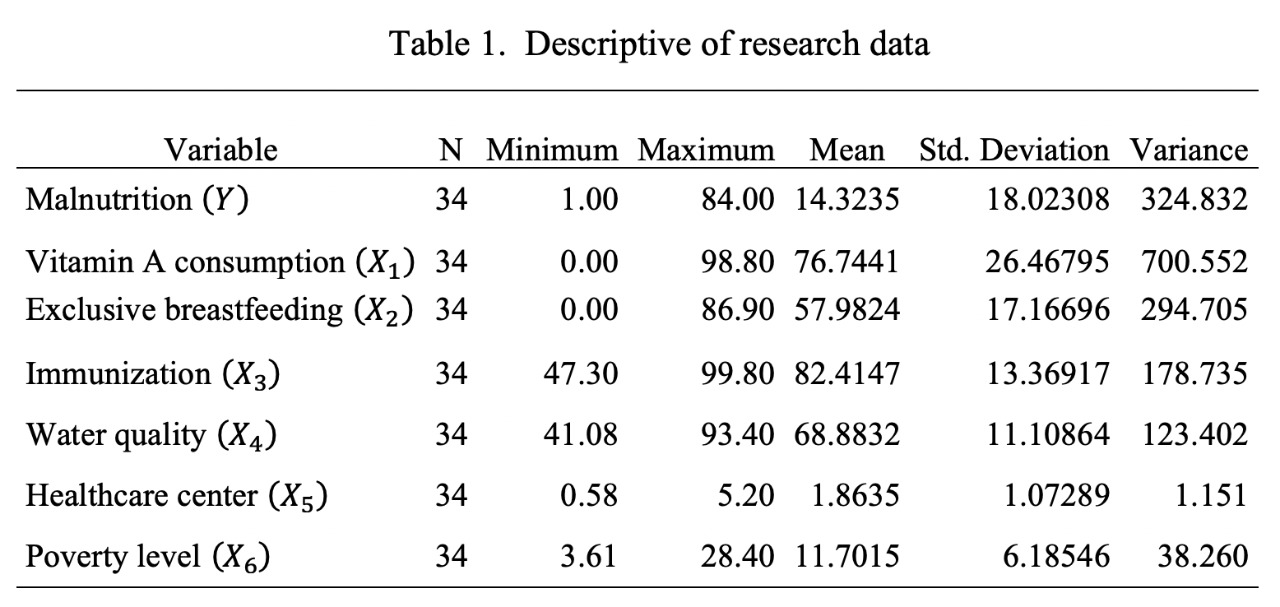Applying negative binomial regression analysis to overcome the overdispersion of Poisson regression model for malnutrition cases in Indonesia
DOI:
https://doi.org/10.12928/bamme.v2i2.4948Keywords:
Malnutrition, Poisson Regression, Overdispersion, Negative Binomial RegressionAbstract
Indonesia is one of the developing countries that is struggling to eradicate malnutrition problem. Malnutrition that occurs over a long period of time can have an impact on deaths for the sufferers and decreasing human’s quality of life. This study aims to model the case of malnutrition that occurred in Indonesia Provinces during 2015, and get the main factors that cause malnutrition problem. Variables studied consists of Malnutrition (Y), Vitamin A consumption (X1), Exclusive breastfeeding (X2), Immunization (X3), Water quality (X4), Healthcare center (X5), and Poverty level (X6). Based on the Kolmogorov-Smirnov test, the results of malnutrition data in Indonesia Province in 2015 does not follow Poisson distribution because of overdispersion. The presence of overdispersion cases in the Poisson regression model will have an impact on the inappropriateness of inferences. An alternative model that can accomodate this case is negative binomial regression model. By using this model, factors that are considered influencing malnutrition cases in Indonesia provinces in 2015 are Immunization (X3), Water quality (X4), and Poverty level (X6). The best model obtained from negative binomial regression analysis is μ ̂_i=exp(2.5111-0.0338X_3+0.0295X_4+0.0576X_6).
References
Abedi, A., & Srivastasa, J. P. (2012). The Effect of Vaccination on Nutrition Status of Pre-School Children in Rural and Urban Lucknow. J. Acad. Indus. Res., 1(4).
Arif, G., Farooq, S., Nazir, S., & Satti, M. N. (2012). Child Malnutrition and Poverty: The Case of Pakistan. Islamabad, Pakistan: Pakistan Institute of Development Economics.
Filteau, S. (2000). Role of Breast-Feeding in Managing Malnutrition and Infectious Disease. Proceeding of the Nutrition Society, 59(4). Cambridge.
Hilbe, J. (2011). Negative Binomial Regression 2nd edition. Cambridge, UK: Cambridge University Press.
Inguita, R., Islam, K. M., & Hossain, M. M. (2009). Analysis of the Relation between Rural Poverty, Malnutrition and Hunger, and the Interlinks with Agricultural Production Growth and Productivity Growth with Special Reference to Mozamique and Bangladesh. Helsinki: Discussion Papers No. 32 Department of Economics and Management University of Hensinki.
Ismail, N., & Jemain, A. A. (2007). Handling Overdispersion with Negative Binomial and Generalized Poisson Regression Models. Casualty Actuarial Social Forum, Winter 2007.
Kadima, Y. (2012). Factors Influencing Malnutrition among Children under 5 Years of Age in Kweneng, West Distrik of Botswana. Pretoria: Dissertation, University of South Africa.
Ministry of Health the Republic of Indonesia. (2016). Health Profile of Indonesia 2015. Jakarta.
Muchina, E. (2007). Maternal Breastfeeding Practices in Relation to Growth and Nutrition Status of Children Aged 0-24 Months in Nairobi, Kenya. Nairobi: Dissertation, University of Nairobi.
Olsson, U. (2002). Generalized Linear Model- An Applied Approach, Studenlitteratur. Lund, Sweden.
Tette, E. e. (2015). Factors Affecting Malnutrition in Children and the Uptake of Interventions to Prevent the Condition. BMC Pediatric.
van der Hoek, W., Feenstra, S. G., & Konradsen, F. (2002). Availability of Irrigation Water for Demestic Use in Pakistan: Its Impact on Prevalence of Diarrhoea and Nutrition Status of Children. J. Health Popul. Nutr. 20, 77-84.
Vorster, H. (2010). The Link between Poverty and Malnurition: A South African Perspective, Heathh SA Gesondheid. Journal of Interdisciplinary Health Sciences, 15(1).
Zwilling, M. (2013). Negative Binomial Regression. The Mathematica Journal.

Downloads
Published
Issue
Section
License
Copyright (c) 2022 Yudi Setyawan, Kris Suryowati, Dita Octaviana

This work is licensed under a Creative Commons Attribution-ShareAlike 4.0 International License.
Authors who publish with this journal agree to the following terms:
- Authors retain copyright and grant the journal right of first publication with the work simultaneously licensed under Creative Commons Attribution License that allows others to share the work with an acknowledgement of the work's authorship and initial publication in this journal.
- Authors are able to enter into separate, additional contractual arrangements for the non-exclusive distribution of the journal's published version of the work (e.g., post it to an institutional repository or publish it in a book), with an acknowledgement of its initial publication in this journal.
- Authors are permitted and encouraged to post their work online (e.g., in institutional repositories or on their website) prior to and during the submission process, as it can lead to productive exchanges, as well as earlier and greater citation of published work (See The Effect of Open Access).



